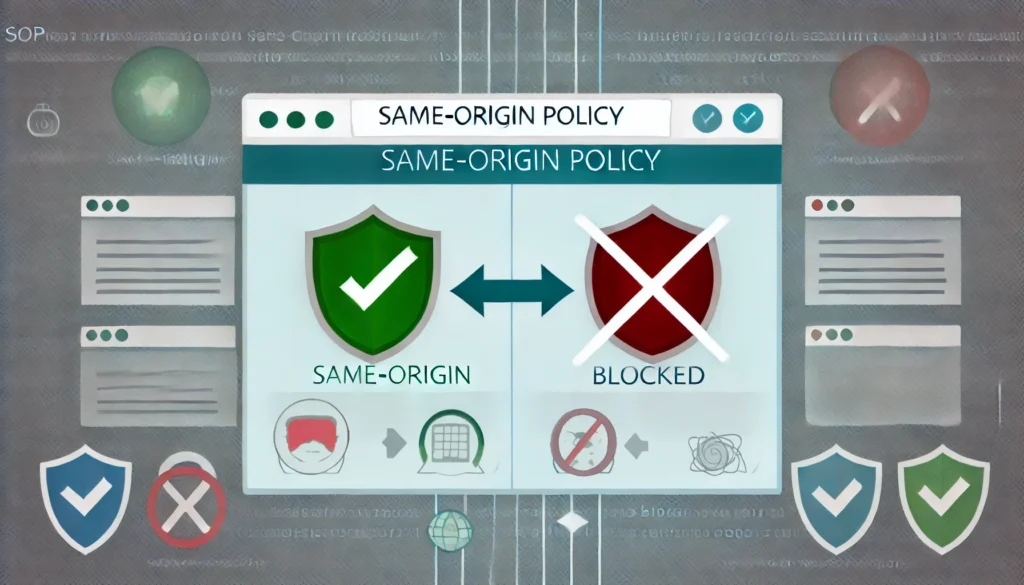
Have you ever wondered why a website you visit can’t access your cookies or session data from other sites you have open, like Facebook or Instagram? That’s thanks to the Same-Origin Policy. This policy restricts how one website can interact with resources from another website in your browser, ensuring your data remains secure and private.
Key Points:
- Origin: An “origin” is defined by the combination of a URL’s protocol (http or https), domain (example.com), and port (if specified). For example,
https://example.com:443andhttp://example.comare considered different origins. - Restriction: The Same-Origin Policy restricts a web page from making requests to a different origin. This means that scripts running on one web page cannot access data or interact with another web page from a different origin.
How It Works:
- Access Control: If a script from
https://example.comtries to make a request tohttps://anotherdomain.com, the browser will block this request to prevent potential security issues, like stealing sensitive data. - Data Protection: It prevents malicious websites from reading sensitive data from other websites you might be logged into, like your email or banking site.
A script on https://example.com cannot access data on https://anotherdomain.com because they have different origins.
Why It’s Important:
- Security: It prevents malicious websites from accessing your data on other sites without your permission.
- Privacy: It ensures that your personal information and session data are not exposed to unauthorized websites.
Exceptions and Relaxations:
- CORS (Cross-Origin Resource Sharing): A mechanism that allows controlled access to resources on different origins. Websites can explicitly permit cross-origin requests using specific HTTP headers.
- JSONP (JSON with Padding): A technique that allows cross-origin requests by exploiting the
<script>tag, which is not subject to the same-origin policy. - PostMessage API: A method that allows secure communication between windows or iframes from different origins.
Browser Vulnerabilities
Note that Same-Origin Policy (SOP) is not set through security headers like Content-Security Policy (CSP). Instead, it is a built-in security feature of web browsers.
Hence, it is bugs or vulnerabilities in browser implementations can sometimes be exploited to bypass SOP. And such bugs have occurred from time to time. Here are a few notable historical examples:
1. Firefox SOP Bypass (2015)
- Description: A critical bug in Mozilla Firefox allowed an attacker to bypass SOP and execute arbitrary code.
- CVE: CVE-2015-4495
- Details: The vulnerability was in the handling of
SVGfiles. An attacker could craft a malicious SVG file that, when loaded by the browser, would execute code in the context of another domain. - Impact: This allowed attackers to steal sensitive information, such as cookies and session tokens, from other websites.
- Fix: Mozilla patched the vulnerability in subsequent updates to Firefox.
2. Internet Explorer SOP Bypass (2014)
- Description: A vulnerability in Internet Explorer allowed attackers to bypass SOP through a flaw in the handling of CORS requests.
- CVE: CVE-2014-1776
- Details: The issue was related to how Internet Explorer handled CORS headers and allowed cross-origin data access under certain conditions, even when it should have been blocked.
- Impact: Attackers could perform unauthorized actions on behalf of the user, including stealing data and executing scripts.
- Fix: Microsoft released a security update to address the issue.
3. Safari WebKit SOP Bypass (2021)
- Description: A bug in WebKit, the browser engine used by Safari, allowed an attacker to bypass SOP.
- CVE: CVE-2021-1844
- Details: The vulnerability was caused by improper handling of origin checks in WebKit. An attacker could exploit this bug to execute scripts in the context of another origin.
- Impact: This allowed attackers to access sensitive information and perform actions on behalf of the user on other websites.
- Fix: Apple released updates for Safari to patch the vulnerability.
4. Chrome SOP Bypass via AudioContext (2018)
- Description: A vulnerability in Google Chrome’s handling of the
AudioContextinterface allowed SOP bypass. - CVE: CVE-2018-6177
- Details: The bug allowed attackers to exploit the
AudioContextinterface to gain unauthorized access to data from other origins. - Impact: This could be used to steal data or perform actions on other websites as if they were from the same origin.
- Fix: Google released a security update to Chrome to resolve the issue.
